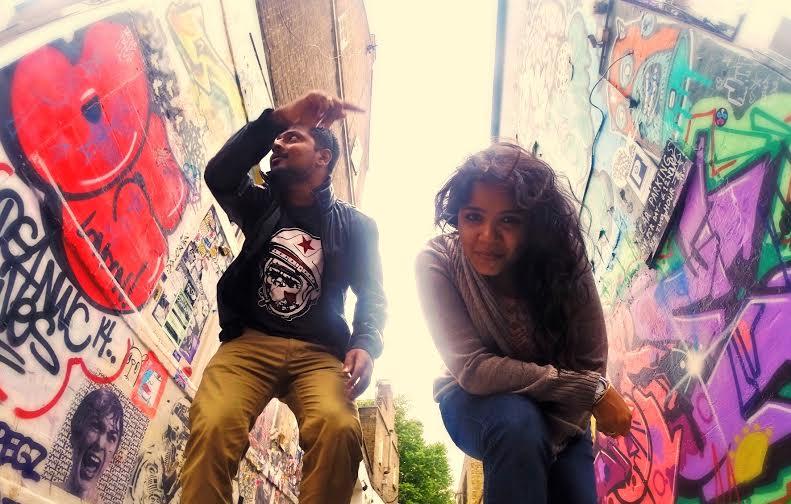 NIL
NIL
Ethnic with a twist
Who would have ever thought that a group of music-minded youngsters would borrow a universally famous Indian decoction for the name of its music band? But Filter Coffee does exactly that, Shoma A. Chatterji reports
It is a new way of approaching music. ‘Filter Coffee’ is an Indian Ethnotronic collaborative effort brought to life by tabla player and percussionist Swarupa Ananth and flautist Shriram Sampath. Their live performances feature a range of guest artistes across genres providing a new look at Hindustani classical music as they combine traditional tabla, flute and vocals with hypnotic electronic grooves and textured sounds.
Swarupa Ananth-Sawkar who plays a whole gamut of percussion instruments like djembe, darbuka, cajon, dhol, etc says, “My entire life is within music and without music there is no life. Cliché but true!”
Shriram Sampath, a flautist, the other leading member of the group, says, “We prefer to call this a global collaborative, its USP- featuring a new artiste every time and of bringing a different dimension.” He says that the term ethnotronic was coined by someone and they picked it up. “We were playing at a club in London last year and the promoter who made the poster called us Ethnotronic. It stands for crossover - Indian ethnic and electronic music.”
But why the intriguing name Filter Coffee? Says Sampath, “Flyod Maxell says coffee is creative lighter fluid which is incredibly true for me. Coffee inspires me in its own way. I had been working on this music for a long time and when the time came to give it a name, there wasn’t anything fresher and better sounding than Filter Coffee for a band name. And Filter Coffee is an acceptable addiction from the place where I come from, South India.”
Jahnvi Shrimankar, the slim and svelte vocalist of the group with an amazingly versatile repertoire says, “I got to know both Shriram and Swarupa separately I was keen on working together, and Filter Coffee had been looking for vocalists to feature in their gigs. That’s how I started performing with them.” She adds, “When it comes to music, money is not my top priority. For an artiste, it’s more important to experience creative fulfillment. Filter Coffee’s music was that for me.” Jahnvi brings in her inimitable vocal style with bandishes and alaaps to the songs created by Filter Coffee.
There is a fourth member who conceives and executes the visuals for their live concerts. She functions as the official visual jockey for the group when they are touring. Multi-talented Shreya Naik aka Plan B takes the audience through a spectacular visual journey with Filter Coffee. She runs two start ups, Dream Makers and Artsy Fartsy Co that handle music and arts respectively. Artist management, music curating, talent scouting are conducted under Dream Makers and the rest art related activities are done by Artsy Fartsy. “My company sells art products by upcoming doodlers and artists and I design and conceptualize public art projects. These installation involve people to complete them,” Shreya says. She, however, does not visualise any particular set of images for the music numbers. “Most of it happens on the fly while they are performing and I allow my imagination to go wild with each item played. Visuals add a different dimension to the performance.”
Though Filter Coffee is only around six years, it has performed at Brunswick and Sussex in the UK, Malaysia, Indonesia, UK and India. It is one of the few bands in the country to have played festival stages internationally this year.
Jahnvi’s ‘Slowdown Kalandar’ is low-key, subtle and soulful. Was this by design? Shriram says, “Slowdown Kalandar and some other numbers are a little more mellowed than other songs but this happened without any conscious effort.” These songs are strongly influenced by classical raagas. He wrote a new arrangement for Slow Down Kalandar and it is easily one of the most popular cover songs in their repertoire. “While the traditional mast kalandar is driven by energy and tempo, I wanted to slow it down, add some textures, sit back and see if it still sounded as magical as did the original.”
They also perform popular Hindi film songs depending on the audience. The challenge was to look at things from a different perspective.
Asked about audience response to their kind of music, Swarupa says, “The best part about our audience is that we’ve played to all age groups of people. In the beginning, we were sceptical about how the older generation would accept Indian classical with a twist of electronic music, but the response from them has been overwhelming. Audiences are getting more liberal towards new and experimental music which makes the scene more vibrant. Watching my audience groove, dance and even participate in my music is the greatest motivation to be on stage again and again.”
Top Headlines
-
Entertainment
Valentyn Vasyanovychs To The Victory! wins 2025 TIFF Platform Award unanimously
September 26, 2025
-
Entertainment
Chlo Zhaos Hamnet Wins TIFF 2025 Peoples Choice Award
September 20, 2025
-
Entertainment
Sholay: Golden even after fifty years
July 04, 2025
-
Entertainment
War 2: Check out Hrithik Roshan, Jr NTR and Kiara Advani's new posters
June 26, 2025
-
Entertainment
LGBTQIA+: Icelandic film Odd Fish and Brazil's Baby win big at KASHISH 2025 film festival
June 12, 2025
-
Entertainment
Katrina Kaif named Maldives tourism global brand ambassador ahead of Modi's visit
June 10, 2025
-
Entertainment
'Queen marches to conquer': Deepika Padukone joins Atlee's AA22xA6 starring Allu Arjun after 'Spirit' exit
June 08, 2025
-
Entertainment
Dakota Johnson and Chris Martin, who were in on-and-off relationship, broke up: Reports
June 06, 2025
-
Entertainment
Sharmila Tagore to Alia Bhatt, India weaves cross-generational tale at Cannes 2025
May 28, 2025
-
Entertainment
Is Sandeep Reddy Vanga's cryptic 'feminism' post meant for Deepika Padukone? Neitzens think so
May 27, 2025


